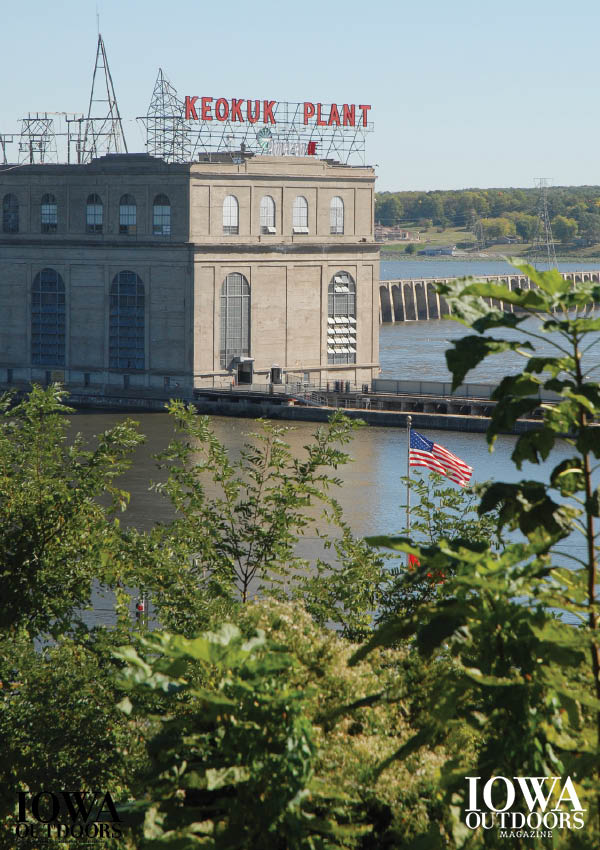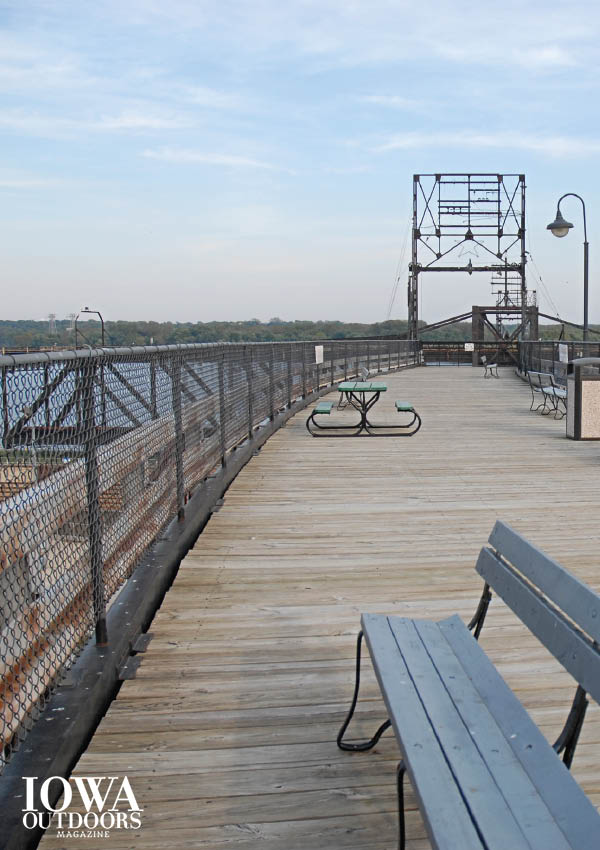In Keokuk—Iowa’s southernmost city—it’s always numerous degrees warmer, so cozy up with eagles, ducks and pelicans and a fancy bed in Lee County.
From the March/April 2017 issue of Iowa Outdoors magazine
Subscribe now
Marilyn Engler wants you to know a little about the southeastern Iowa town of Keokuk.
First, says this tour guide aboard the Keokuk River Museum on the sternwheel steamboat George M. Verity, Mark Twain once lived here.
 Secondly, the town of about 11,000 is named for Keokuck, chief of the Sauk and Fox after Black Hawk. (Engler will tell you, if you’re not delicate, that at first Keokuck’s head wasn’t with him when he was buried here).
Secondly, the town of about 11,000 is named for Keokuck, chief of the Sauk and Fox after Black Hawk. (Engler will tell you, if you’re not delicate, that at first Keokuck’s head wasn’t with him when he was buried here).
Also, adds Engler, hands clasped behind her back, a white blouse and black skirt setting off her captain’s cap, Keokuk was once larger than St. Louis, and known as the Gate City of the West. That’s why the daily paper is still called the Daily Gate City.
Engler can reveal much more about Keokuk and Lee County, but you might investigate this inexpensive road trip yourself to bust the winter blues.
Fowl winter
Keokuk is like many of Iowa’s river cities. Housing stock that speaks of glory days long past. Empty storefronts like gap teeth on a once-thriving 1800s brick Main Street.
But the city has other, more promising, river town qualities, too. A storied history, for starters. For example, Lee County was once known as the Half Breed Tract, segregated by white families and those where white (usually French) adventurers, trappers and traders intermarried with Sauk and Fox women. (For more information about the Half-Breed Tract, read http://iagenweb.org/lee/land/halfbreed/hbtitle.htm.
There’s also a small but spunky population of boosters working hard toward revival with success. The local Siemens energy plant is turning out wind turbine blades 24 hours a day to meet the booming wind energy industry. Harnessing the river, barges will ship the towers to regional destinations.
You have to break through a tough veneer of chain stores to get to the old character of the city. Main Street is long and wide, leading right to the river, with attractive brick buildings. Restaurants, bars and shops are still here, some quite good, including, Fiesta Jalisco Mexican restaurant and Dr. Getwell’s Bar and Grill. You can catch a first-run movie in the small-but-still-standing mall if the weather isn’t cooperating.
Winter visits will consist largely of birdwatching, with a round of ice-skating at the far end of scenic, historic Grand Avenue, at riverfront Rand Park, where Keokuck is buried at the base of his statue. Stay at one of the B&Bs on Grand for a spot of local history and gourmet breakfast.
In summer, you might stay at rustic Shimek State Forest, also a birding hotspot, with 25 miles of hiking and 27 miles of multi-use trails for horses, bikes and hiking boots.
The Mississippi flows past Keokuk, on what was once a stretch of rapids so perilous that boats had to stop here (thus the boom of the early 1800s). To open to commerce, Congress authorized the construction of a canal and locks along the river’s edge, which opened to traffic in 1877. The year 1913 saw the addition of a dam, powerhouse and lock and dry dock.
This is Lock and Dam 19, still the largest on the entire river, and during winter, the equivalent of the Ritz Carlton for migrating bald eagles and ducks.
 “It’s arguably Middle America’s most important layover for migrating canvasback, lesser scaup and ringneck ducks,” says Bob Cecil, a Keokuk native and birding expert from Des Moines, who notes the ducks number at least in the tens of thousands, scouring shallow waters for clams, mussels and aquatic vegetation.
“It’s arguably Middle America’s most important layover for migrating canvasback, lesser scaup and ringneck ducks,” says Bob Cecil, a Keokuk native and birding expert from Des Moines, who notes the ducks number at least in the tens of thousands, scouring shallow waters for clams, mussels and aquatic vegetation.
Here, the largest concentration of eagles on the river roosts from late December on, scavenging stunned or dead fish shooting through the dam. Keokuk hosts the 34th annual Bald Eagle Appreciation Days January 20-21, 2018 (www.keokukiowatourism.org/eagledays.htm).
Rock hounding
There’s another natural treasure in Lee County, if you get here during a thaw. The Keokuk geode found in a 35-mile radius of town is the world’s most prized, for the exquisite variety of minerals in its crystalline interior.
Robert and Andrea Kelly have been collecting and selling rocks for about 11 years. They met and married after bonding over their geode passion.
“Our idea of a good date before we were married was going out and looking for rocks,” he chuckles. “It’s a truly kind of a gem of a marriage, it is!”
Folks have come to Keokuk from as far as Japan to rock hunt, following river beds via canoe or slogging through water searching the limestone bluffs in which geodes are often imbedded.
“We’ve walked for miles up creeks and riverbanks,” says Robert. “We’ve climbed riverbanks that shouldn’t’ve been climbed.”
Andrea says its best to hunt after a good rain, anywhere the river has cut into the earth. Scout access roads and ask around, securing permission before entering private property.
“It’s like mushroom hunting,” Andrea says of getting an eye for geodes, noting the peculiar round shape and a cauliflower-like texture on a gray or brown exterior.
For travelers interested in the anatomy of a river town one hundred-some years after the boom, Keokuk is an interesting example. Comfortable restaurants, the dark beauty of river ecology and the glimmer of history is upon it. If you need more reasons to visit, just ask Engler, who’s lived here for more than five decades: “Keokuk is the best little town along the Mississippi!”
Those Crazy Birds
Sure, you’re into Pool 19 eagle watching. But what exactly are you watching for? Some facts about our national bird:
• Seventy percent of the eagle’s feeding occurs before 9 a.m., so avoid eagle-watching earlier than that.
• Eagles are hardcore scavengers. “I’ve even seen them out in the middle of a harvested cornfield, eating a dead deer,” says state forester John Byrd.
• You can age an eagle by the proportion of black to white on the wings and tail. They don’t get their white head and tail until they’re 4 to 5 years old.
• Most serious birders consider eagles too common to be of interest. This is good news, considering eagles were endangered just decades ago.
Birding for Beginners
Lee County’s Shimek State Forest is a designated Bird Conservation Area. According to birding expert Bob Cecil, the beginner needs only gas in the car and a bird guide. His suggestions, which can be purchased at Birdwatching’s website, www.birdwatching.com; 641-472-7256, in Fairfield, Iowa:
• The Sibley Field Guide to Birds of Eastern North America
• National Geographic’s Field Guide to Birds of North America
• Peterson’s Guide for Birds of Eastern and Central North America
Binoculars aren’t necessary for beginners, but if you’re in the market, Cecil says you can get an excellent pair for around $300. “It’s almost an imperceptible difference between those and what you spend $1,000 on,” he says. If you don’t want to research, stick with a brand you’ve heard of, such as Nikon.
For more information, contact the Iowa Ornithologists Union (www.iowabirds.org).